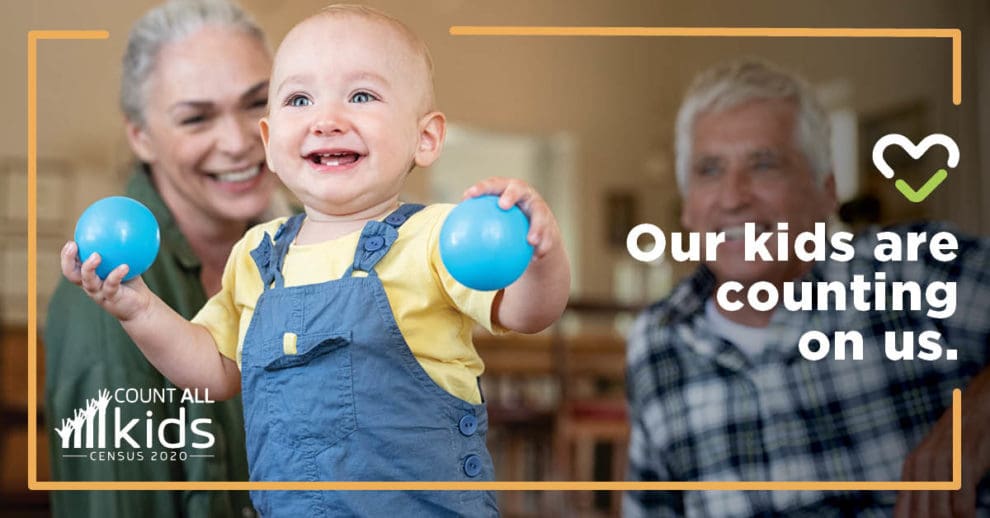
On April 1, tell people to count all children at their address who have no permanent residence.
As the spread of the Coronavirus has increased, the vulnerabilities within our system have become clear. Children and families living in poverty and experiencing homelessness already lack the financial stability to access nutritious food, stable housing, healthcare, and all of the resources needed to support a child’s healthy development consistently. A public health crisis – when resources are scarce for everyone – only exacerbates these needs.
While we are all busy urging decision-makers to take action and fund resources to support children and families hit hardest by this outbreak, we must also remember that we cannot show the true needs of all of our nation’s children and families without an accurate 2020 Census count.
This Wednesday, April 1st is Census Day, the official start to the 2020 decennial census which now – due to the Coronavirus – runs from April 1st to August 14th. Notices about responding to the Census have already gone out to many homes, and as of Sunday, March 29th, 33.1 percent of households nationwide have already responded to the Census via online, phone, or mail.
While this is a good start, we know there are many households that are unlikely to self-respond on their own or may leave children off the form when responding. In 2010, two million children were missed in the Census and those most at risk of being undercounted include young children in families and unaccompanied youth living in very transient situations who are experiencing homelessness or housing instability.
We already know that these children and youth represent a sizable population. According to data from the Department of Education, public schools identified more than 1.5 million homeless students in the 2017-2018 school year, a 10 percent increase since the previous school year. In addition, the landmark 2017 study, Missed Opportunities: Youth Homelessness in America, from Chapin Hall at the University of Chicago found that 4.2 million young people experienced homelessness on their own over a 12-month period.
The majority of these children and youth are in “doubled-up situations” meaning they are living with others because they have nowhere else to go. These are often overcrowded, unstable and very temporary situations that put children at high risk of predation, trafficking, and abuse.
The recent Coronavirus outbreak only serves to put more children and youth at risk of homelessness or housing instability. As businesses close or reduce hours, and consumers stay home, low-income household budgets are being stretched even thinner, with less money for rent and utilities. Children and youth already experiencing homelessness are being put into even more perilous situations. They may be kicked out of doubled-up situations or be stuck in overcrowded and stressful environments all day due to school and childcare closures that make social distancing, quarantining and remote learning nearly impossible.
Children experiencing homelessness and housing instability have poorer educational and health outcomes than their stably housed peers. This has consequences for their future success, as well as our country’s economic future. Yet these same children and youth most in need of resources such as healthcare and educational support are the ones at high risk of being missed during the 2020 Census. If they are missed, they risk not being taken into consideration when communities receive and allocate resources based on census data.
The U.S. Census Bureau guidelines are clear that if people are staying in your home on April 1, including babies and young children, and they have no permanent home elsewhere, you should count them on your Census form. This includes temporary residents — whether related or unrelated — unless you know they are being counted elsewhere. So even if a family is staying at an address and not paying rent, all members of that family, including young children, should be included on the census form for that address. Grandparents, foster parents, or legal guardians who are caring for young children or babies should include them on the census form for that address as well.
If families with children or unaccompanied youth are not sure if they are being included on the census form at the address where they are temporarily staying, then they should self-report to the U.S. Census Bureau on their own to ensure they are counted. They can use the online or phone response system, and just use the address they are staying at on April 1.
The Count All Kids committee, a group of national, state and local children’s organizations dedicated to ensuring our nation’s children are counted in the 2020 Census, has a toolkit of materials to help with outreach to the millions of children in families or unaccompanied youth experiencing homelessness or housing instability. These materials use tested messaging that stress the importance of a full count to help determine how much money communities get for vital resources for children as well as stressing that the Census has the strongest confidentiality guarantees in the federal government. They also have resources saying explicitly to count everyone at that address on April 1 with no permanent residence.
While we are all rightfully focused on the current Coronavirus outbreak, we must also remember that an accurate 2020 Census has implications for the next 10 years – the span of a full childhood – and can help ensure that children and youth most impacted by Coronavirus get all of the resources they need to be healthy, safe and successful.
For more information on the undercount of children in the Census and how to take action, visit www.countallkids.org and follow Count All Kids on Twitter at @CountAllKids.
